Abstract
In magnesium–rare earth–transition metal (Mg-RE-TM) alloys, the γ” phase (with a hexagonal structure with the space group P2m) is a critical strengthening phase that can significantly improve their mechanical properties. However, compared to other phases in Mg-RE-TM alloys, research on the γ” phase is less documented, and an understanding of the γ” phase is not well established. As a result, different models of the structure of the γ” phase have been proposed. In this review, we summarize these structural models and find that the γ” phase is different from the Guinier–Preston (G.P.) zone, as revealed via Cs-corrected high-angle annular dark field-scanning transmission electron microscopy (HAADF-STEM) and density functional theory (DFT) calculations. In addition, we briefly summarize the stability of the γ” phase and its effect on the mechanical properties of Mg-RE-TM alloys.
1. Introduction
Magnesium–rare earth–transition metal (Mg-RE-TM) alloys have been developed to be superior-strength and age-hardenable alloys [1,2]. They have potential applications in the aerospace and aviation industries, the weapon and defense industries, as well as the auto industry and other civil industries [1]. RE elements (i.e., Gd, Y, etc.) are added to improve the mechanical properties of Mg alloys [1,2]. TM elements (i.e., Zn, Ag, etc.) are micro-alloyed together with the RE elements to constitute different strengthening phases. The main strengthening phases in Mg-RE-TM alloys include prismatic β series precipitates [3,4,5,6] and basal-plate-like precipitates that include the γ’ [7,8]/long-period stacking ordered (LPSO) phase [9,10,11,12,13] and γ” phases [7,14,15,16,17]. These strengthening phases play a critical role in determining the mechanical properties of these alloys [18]. Research on the γ” phase in Mg-RE-TM alloys is relatively less documented when compared to the extensive work on the γ’/LPSO phase and β series phases. In addition, the γ” phase has not been unambiguously distinguished from the Guinier–Preston (G.P.) zone in the literature [7,14,15,16,19,20,21,22,23,24,25,26,27,28,29,30]. Therefore, in this review, we mainly focus on the structure and stability of the γ” phase and its effect on the mechanical properties of Mg-RE-TM alloys.
2. Structure of the γ” Phase
The structure of the γ” phase has been inconsistently documented in the literature. In 1980, Nuttal et al. [26] observed basal-plate-like precipitates (they had designated the precipitated phase γ”) during aging in a dilute Mg-Nd-Zn alloy. The aging sequence was as follows: supersaturated solution→low temperature reaction→γ”→γ [26]. Here, the γ” phase exhibited a hexagonal structure with lattice parameters of a = aMg, c = 3cMg (a = 0.556 nm, c = 1.563 nm). The orientation relationship between the γ” phase and Mg matrix was (0001)γ” [10]γ”//(0001)Mg [2]Mg. In their opinion, the low-temperature reaction in the aging sequence was caused by the formation of either short-range order or a G.P. zone before the ordered γ” phase. In other words, they regarded the G.P. zone as the phase prior to the γ” phase. It was claimed in their paper that no evidence for G.P. zone formation could be found via electron microscopy or selected area diffraction at that time due to the technical limitations of electron microscopy [26].
In contrast to the studies by Nuttal et al. [26], Ping et al. [27] proposed that the basal-plate-like precipitates (typically less than 10 nm in diameter and 1 nm in thickness, as shown in Figure 1) in a Mg-RE-Zn-Zr alloy exhibited an ordered G.P. zone structure (hexagonal, a = 0.556 nm) as shown via a three-dimensional atom probe (3DAP) and TEM at that time. Note that the γ” phase and the G.P. zone were also not regarded as the same phase here.

Figure 1.
G.P. zones observed by TEM. (a) Bright-field TEM image showing G.P. zones and (b) HRTEM image of a G.P. zone formed on a single (0001)Mg plane. The electron beam is parallel to [110]Mg. Reproduced with permission from [27].
The atomic arrangement of the plate-like precipitates observed by Ping et al. is similar to that of the G.P. zone found by Nishijima et al. [19,20]. From the experimental observations of Mg-Gd-Zn alloys, Nishijima et al. proposed a model of the G.P. zone [19], in which a closed-packed plane of Mg atoms was sandwiched by two close-packed planes with Gd and/or Zn atoms occupying ordered positions (Figure 2). In addition, the G.P. zone had an ABAB stacking sequence of close-packed planes, the same as that of the Mg matrix, and had no strain field at the termination with the Mg matrix [19]. Additionally, Saito et al. [20,31] found microstructural changes of the G.P. zones during aging, which will be discussed later in Section 3.
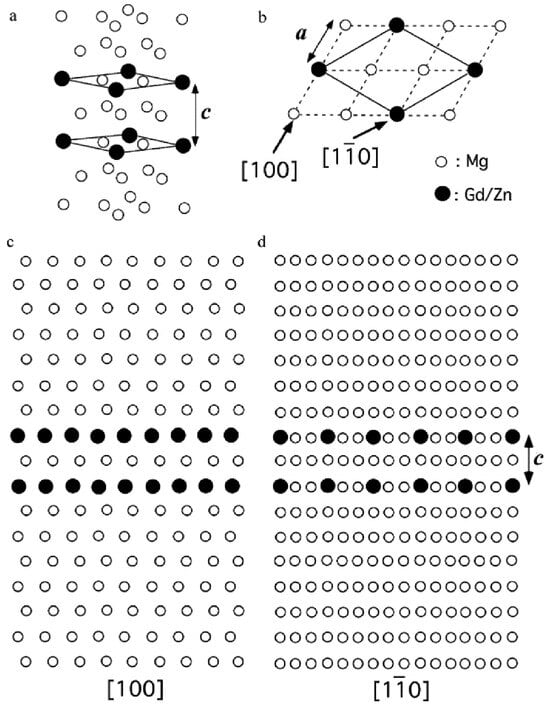
Figure 2.
Nishijima’s model of the G.P. zone. Schematic drawings of the structure model of the G.P. zone (a,b) and projected atomic arrangements along [100] (c) and [10] direction (d). Reproduced with permission from [20].
Regarding the previously mentioned basal-plate-like precipitates, Gao and Nie [32] thought it might not be appropriate to define the thicker basal plates as ordered G.P. zones. Based on HAADF-STEM images (Figure 3) and the Z-contrast principle [33], Nie et al. [7] pointed out that the γ” phase was not the ordered G.P. zone reported by Ping et al. [27] and could not be described by Nishijima’s model [19]. They found that the γ” phase had an ordered hexagonal structure (space group P2m, a = 0.560 nm) with a single unit cell height (c = 0.444 nm), leading to a negative misfit (−0.16) between the γ” phase and Mg matrix along [0001]γ”//[0001]Mg and a composition of approximately Mg70Gd15Zn15 measured by 3DAP in a Mg-Gd-Zn alloy [7]. Additionally, the middle layer of the three-layered γ” plate was not pure Mg but enriched with Zn in their model [7]. In other words, the γ” phase was composed of Gd-enriched layers and Zn-enriched layers.
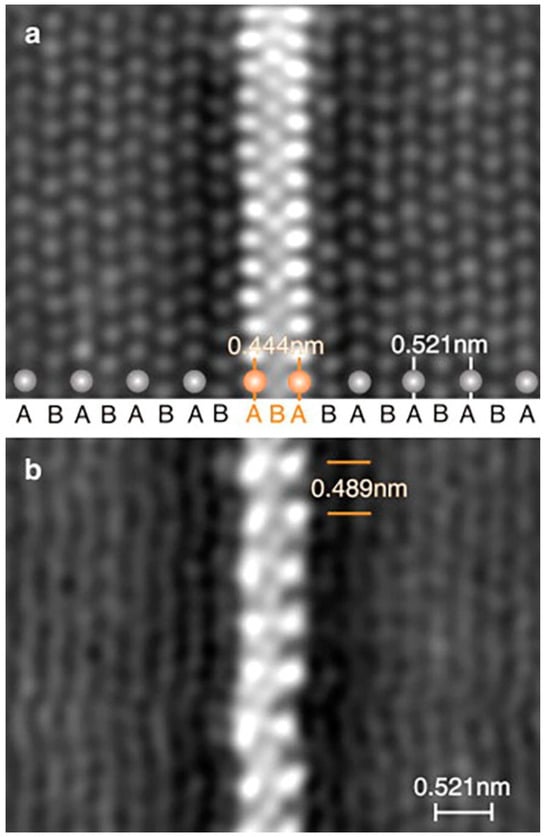
Figure 3.
Atomic-scale HAADF-STEM images showing the γ” precipitate in a Mg-6Gd-1Zn-0.6Zr alloy (wt.%) aged for 2 h at 250 °C, viewed in the (a) <110>Mg and (b) <10>Mg directions. Reproduced with permission from [7].
Similar to Nie’s opinion, Zhu et al. [34] also distinguished the γ” phase from the G.P. zone. Specifically, they proposed that the G.P. zone had a single atomic layer on (0001)Mg, while the γ” phase had three atomic layers in a Mg-6Y-2Ag-1Zn-0.6Zr (wt.%) alloy with the help of HAADF-STEM observations and DFT calculations. In their model, the γ” phase had an ordered hexagonal structure (P6/mmm, a = 0.556 nm, c = 0.450 nm), and the atomic positions in the central layer were displaced when observing not only along the <10>Mg direction, but also along the <110>Mg direction. The γ” phase in their model was enriched with Ag instead of Zn, and the atomic positions in the central layer were not unambiguously determined.
Note that in Nie’s model, the position of Zn in the Zn-enriched middle layer of the γ” structure was also not determined. To address this issue, Li et al. [15] proposed a model of the γ” structure that was conformed with the HAADF-STEM observations in a Mg-Gd-Zn alloy (viewed from both the [110]Mg and [10]Mg directions by displacing a (0001)Mg plane along [110]Mg with a distance of 0.80 Å (i.e., aMg/4)). In their model (Figure 4), the Zn atoms occupy certain atomic sites in the middle layer of the γ” structure. However, the displacement in their model will cause projections of the atomic structure that are inequivalent along three <10>Mg or <110>Mg directions, as claimed by Gu et al. [16].
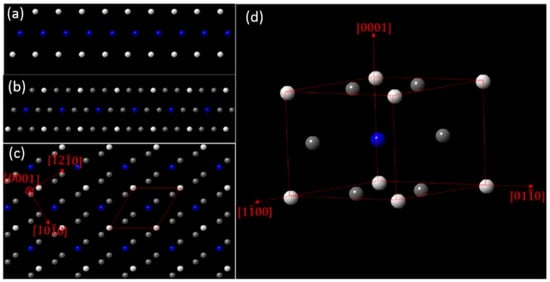
Figure 4.
Li’s model of the γ” phase observed along the (a) [110]Mg, (b) [10]Mg, and (c) [0001]Mg directions, and (d) its unit cell. The white balls represent Gd, the grey balls represent Mg, and the blue balls represent Zn. Reproduced with permission from [15].
Gu et al. [16] considered the γ” phase and the G.P. zone to be the same phase and determined the structure of the γ” phase in a Mg-Gd-Zn alloy by atomic resolution HAADF-STEM viewed from different directions, i.e., [110]Mg, [10]Mg and [0001]Mg, and for the first time directly observed the ordered Gd structure in the (0001)Mg plane (Figure 5). They found that the γ” phase exhibits a hexagonal structure (a = 0.556 nm, c = 0.39 nm), and Zn atoms were centered between Gd atoms in the Zn-enriched middle layer. Figure 6 shows the structural model of the γ” phase proposed by Gu et al., and DFT calculations showed that Nie’s model and Li’s model would converge to Gu’s model after atomic relaxation [16]. Since the Zn content in the composition of the γ” phase measured by a 3DAP was lower than the nominal value (Mg2Zn3Gd1) [16], they assumed that Mg atoms substituted part of the Zn atoms in the middle layer. Considering the effect of the ratio of Zn/Mg in the central layer, they obtained a relaxed phase structure similar to Figure 6g–i.
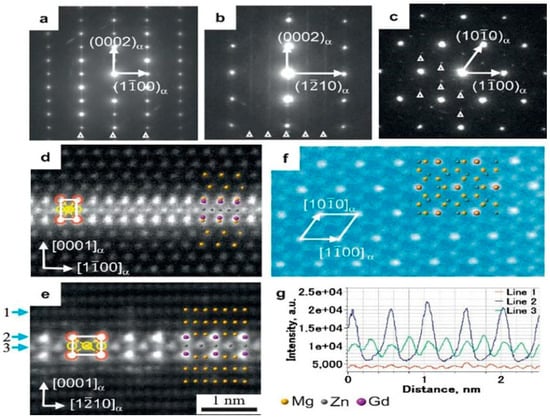
Figure 5.
Diffraction patterns and atomic structures of the γ” phase. (a–c) Diffraction patterns of the γ” phase taken from [110]Mg, [10]Mg and [0001]Mg, respectively. (d–f) Atomic structures of the γ” phase viewed by HAADF-STEM from [110]Mg, [10]Mg and [0001]Mg, respectively, in which a unit cell is highlighted and the relaxed atomic structure is superimposed. (g) Intensity profile from rows 1–3 indicated in (e). Reproduced with permission from [16].

Figure 6.
Different models of the γ” phase. (a–c) Rigid atomic structures proposed by Gu et al.; (d–f) atomic structures proposed by Nie et al.; (g–i) relaxed atomic structures for the initial structures in (a–c), respectively, by DFT calculations. Reproduced with permission from [16].
Similar to Gu’s model of the γ” phase in a Mg-Gd-Zn alloy, Sha et al. [22] proposed an atomic model of the γ” phase in a Mg-Gd-Y-Ag alloy using atomic resolution HAADF-STEM viewed from three independent directions, i.e., [0001]Mg, [20]Mg and [010]Mg, and the γ” phase was also found to exhibit a hexagonal structure with lattice parameters of a = 0.55 nm and c = 0.42 nm.
As mentioned in Gu’s model, the measured composition of the γ” phase by a 3DAP was not consistent with the nominal value. Considering this, Xie et al. [23] tried to clarify the issue and proposed a topologically close-packed (TCP) structure for the γ” phase in the Mg-Gd-Zn alloy. In Xie’s model (Figure 7) [23], the γ” phase has a hexagonal structure with the space group P6/mmm and lattice parameters of a = 0.556 nm and c = 0.521 nm. Moreover, the γ” phase in their model is composed of monolayer atomic icosahedral clusters with five (0001)γ” layers, as shown in Figure 7, with a composition of Mg2Gd2Zn3 that is consistent with the previous 3DAP results [16]. They also treated the γ” phase and the G.P. zone as the same phase.
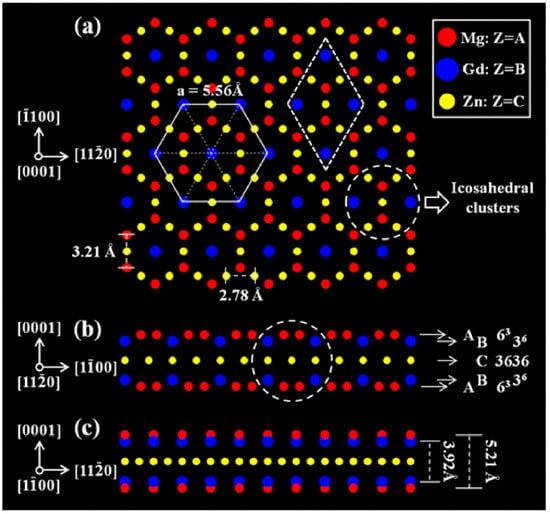
Figure 7.
Xie’s model of the γ” phase. The direction is viewed along the [0001]γ” (a), [110]γ” (b), and [1]γ” (c), respectively. Unit cell of the γ” phase is marked with rhombus frame in (a). Atomic icosahedral clusters in the γ” phase are marked with round frames in (a,b). Reproduced with permission from [23].
Note that the previously reported lattice constants (a and c values) and specific configuration of the γ” phase show discrepancies; in other words, the fine crystal structure of the γ” phase has many variants. To clarify this phenomenon, Bai et al. [24] studied the anomalous structure of the γ” phase in Mg-RE-Zn(Ag) alloys by using first-principle calculations. They verified a new quasi-five-layer structure for the γ” phase, with the middle layer composed of Mg and Zn (Ag) atoms, in accordance with the experimental HAADF-STEM observations [23]. The ordered extent of the atoms in the middle layer increases with decreasing atomic ratio of RE: Zn (Ag) and/or increasing solute content in the alloys. Additionally, they found that the variants (diverse Zn (Ag) fractions in the middle layer of the γ” phase) change with the RE: Zn (Ag) atomic ratio of alloys. For example, when the atomic fraction of Zn in the middle layer increases to 0.43, the related structure is the same as that in Gu’s model. They also claimed that Zhu’s model is thermodynamically unstable, since the formation energy for the Mg-Y-Ag alloy is positive. The dependence of the c value on the RE: Zn (Ag) atomic ratio could explain the different c values in different Mg-RE-Zn(Ag) alloys.
As mentioned above, there is also no consistent definition of the γ” phase, i.e., whether the G.P. zone and the γ” phase are the same phase or not. Some researchers [15,16,22] believe that the γ” phase and the G.P. zone are the same, while Nie et al. [7] believe that the γ” phase is not the G.P zone reported by Ping et al. [27]. By using Cs-corrected HAADF-STEM, in our previous studies [14], we observed in a Mg-Gd-Y-Zn-Ni-Mn alloy that the G.P. zone and the γ” phase were on the same plate, and the subtle difference between them was reflected in their different extents of segregation of Mn atoms (Figure 8). Our DFT calculations also confirmed that the G.P. zone was the precursor of the γ” phase [14].
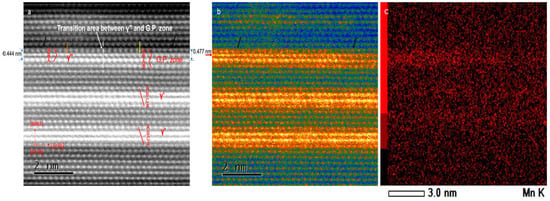
Figure 8.
HAADF-STEM images of an as-cast Mg-Gd-Y-Zn-Ni-Mn alloy. The electron beam is parallel to [110]Mg. (a) High magnification image showing the G.P. zone and γ” and γ’ phases, where the G.P. zone and the γ” phase on the same plate are parallel to [100]Mg with a transition area between them. (b) The image after contrast adjustment shows a significant change in the intensity along the upper plate. The variation in contrast is indicated by black arrows. (c) EDS mapping showing different extents of segregation of Mn atoms on different plates. Reproduced with permission from [14].
Table 1 summarizes the different views on the structure of the γ” phase. Due to the development of electron microscopy (especially employing Cs-corrected HAADF-STEM) and the DFT method, the structure of the γ” phase has been clarified in more detail, and the chemical formula derived from the model of the γ” phase is consistent with the measured 3DAP results.

Table 1.
Views on the structure of the γ” phase.
3. Stability of the γ” Phase
Since there has been no consistent definition of the γ” phase in the literature, as mentioned in Section 2, we include the G.P. zone (Nishijima’s definition) in this review on the stability of the γ” phase. Yasuhara et al. [35] pointed out that the G.P. zone was preferentially formed when the composition ratio of Gd/Zn was 1~1.5; in particular, exclusive formation of G.P. zones without other precipitates was found in alloys with Gd/Zn = 1 and Gd/Zn = 1.5 by annealing at 200 °C for 100 h [31].
The stabilities of the G.P. zone and γ” phase can be reflected by their morphologies. Saito et al. [20] reported that the G.P. zones in Mg-Gd-Zn alloys changed morphology during aging as follows: wavy→planar→band-shaped (multilayered) [20]. The γ” phase in Mg-Gd-Zn alloys shows a saucer shape when viewed along [0001]Mg [23], while it shows a streak shape when viewed along [110]Mg and [10]Mg [15]. As reported by Xie et al. [23], the γ” phase has a diameter of 30~50 nm and a thickness of less than 1 nm lying on the basal plane of Mg.
The stability of the γ” phase at different aging temperatures has been studied. For instance, Choudhuri et al. [17] reported that the γ” precipitates in a Mg-Nd-Zn alloy were stable at about 177 °C for around 4800 h during a creep test (Figure 9). Also, we found that the γ” phase in a Mg-Gd-Y-Ag-Zr alloy was thermodynamically stable at room temperature, and no transformation behavior of the γ” phase was found up to 200 h during isothermal aging at 200 °C [36]. In addition, Bai et al. [25] claimed that the γ” phase remains at its single-unit-cell height during aging at 200 °C.

Figure 9.
Creep of Mg-Nd-Zn. (a) Strain rate–time curves show enhancement in the creep life of Mg-Nd-Zn. (b–d) TEM and HAADF-STEM images taken at points (b–d) marked in (a): (b,c) show β’ precipitates and fine-scale GP zones (arrows), respectively, on the prismatic planes of α-Mg in Mg-Nd; (d) shows γ” and γ precipitates lying on the basal and prismatic planes in Mg-Nd-Zn, respectively. (e) Raw ion maps from atom probe tomography confirm the presence of Zn in the γ” phase along with Nd. The scale bars in (b–d) are 100 nm, 20 nm, and 20 nm, respectively. Reproduced with permission from [17].
The reason for this extreme thermal stability of the γ” phase has been regarded by Nie [28] as one of the four unsolved issues in precipitation-hardened magnesium alloys. To explain the origin, Bai et al. [25] employed a ledge-thickening model and found that it was challenging for the solute atoms to jump into the nearest basal plane adjacent to the γ” phase, rendering ledge nucleation extremely difficult. Moreover, the almost totally coherent -Mg/γ” heterointerface, which lacked stable sites to capture solute atoms, and the lower aging temperature (~200 °C) also led to the nucleation of extremely hard ledges on the heterointerface. Therefore, the γ” phase maintains its thermal stability during the aging process.
Note that the previously reported γ”→γ’→γ [34] precipitation sequence with the progress of aging at 200 °C and/or above 200 °C in a Mg-Y-Ag-Zn-Zr alloy was not found in our investigation into a Mg-Gd-Y-Zn-Mn alloy [3]. In contrast, our study of the Mg-Gd-Y-Zn-Mn alloy showed that the γ” phase coexisted with the γ’ phase at 200 °C for 200 h [3]. Similarly, we found the coexistence of γ” and γ’ phases in a Mg-Gd-Y-Zn-Ni-Mn alloy [14], where Mn facilitated the transformation from γ’ to γ”. However, the reason behind this transformation still needs further study.
4. The Effect of the γ” Phase on the Mechanical Properties
The γ” phase has been regarded as a critical strengthening phase in Mg-RE-Zn(Ag) series alloys and can remarkably improve their mechanical properties [7,25,32,37,38,39]. For instance, Jian et al. [40] reported that high-density nano-spaced γ” precipitate plates in a conventional hot-rolled Mg–8.5Gd–2.3Y–1.8Ag–0.4Zr (wt.%) alloy impeded dislocation movements, leading to an ultrastrong Mg alloy (with a yield strength of around 575 MPa, an ultimate tensile strength of approximately 600 MPa and a uniform elongation of about 5.2%). Additionally, Nie et al. [7,32,39] claimed that the densely distributed γ” phase was the critical strengthening phase corresponding to the peak hardness in Mg-Gd-Zn alloys. Similar results have also been found in other Ag-containing Mg-RE alloys, where high number densities of γ” precipitate plates with lengths of typically less than 50 nm induced remarkable precipitation hardening [7,32,36,37,38,41,42,43,44].
Moreover, the γ” phase can enhance the creep strength of Mg alloys [7,17,28,39,45]. For example, Choudhuri et al. [17] observed a dramatic 600% increase in the creep life of a Mg-Nd-Zn alloy, and attributed the enhancement in creep strength to the high-density γ” precipitate plates on the basal planes (Figure 9).
The intrinsic mechanical properties of the γ” phase were investigated by Bai et al. [24] for the first time in the literature. By using DFT calculations, they found that in Mg-RE-Zn(Ag) alloys with a γ” phase with an identical crystal structure, adding Ag and Zn into the γ” phase could cause nearly opposed mechanical anisotropy, and adding Ag exhibited a superior effect on increasing the shear modulus of the γ” phase. Furthermore, they reported that adding Ag shows a better age-hardening effect than adding Zn for Mg-RE-Zn(Ag) alloys.
Table 2 summarizes the influence of the γ” phase on the mechanical characteristics of Mg-RE-TM alloys. Nevertheless, the effect of the γ” phase on the mechanical properties of Mg-RE-TM alloys, especially the underlying mechanism, still requires deeper investigations for designing high-performance Mg alloys.

Table 2.
Effect of the γ” phase on the mechanical properties of Mg-RE-TM alloys.
5. Conclusions and Future Directions
We provide a brief review of the γ” phase in Mg-RE-TM alloys. Much attention has been placed on the structure of the γ” phase. The combination of Cs-corrected HAADF-STEM and DFT calculations has made it possible to directly compare the proposed crystal models with experimental observations of atomic structures. We find that the γ” phase is different from the G.P. zone. The dependence of the c value on the RE: Zn (Ag) atomic ratio could explain the different variants of the γ” phase. In addition, the γ” phase maintains its thermal stability during the aging process. Moreover, the γ” phase is a critical strengthening phase that can remarkably improve the mechanical properties. Although research data on the stability of the γ” phase and its effect on the mechanical properties of Mg-RE-TM alloys are quite limited, they shed light on the future directions for the field. Regardless, controlling the γ” phase is still a promising direction for designing Mg alloys with a high strength and creep resistance.
Author Contributions
Conceptualization, Z.L. and B.C.; writing—original draft preparation, Z.L.; writing—review and editing, Z.L., Z.P., N.Z., K.Z. and B.C.; funding acquisition, Z.L. All authors have read and agreed to the published version of the manuscript.
Funding
This research was funded by the GDAS’ Special Project of Science and Technology Development (grant no. 2021GDASYL-20210103104).
Data Availability Statement
Not applicable.
Conflicts of Interest
The authors declare no conflict of interest.
References
- Wu, G.; Wang, C.; Sun, M.; Ding, W. Recent developments and applications on high-performance cast magnesium rare-earth alloys. J. Magnes. Alloys 2021, 9, 1–20. [Google Scholar] [CrossRef]
- Zeng, Z.; Stanford, N.; Davies, C.H.J.; Nie, J.-F.; Birbilis, N. Magnesium extrusion alloys: A review of developments and prospects. Int. Mater. Rev. 2019, 64, 27–62. [Google Scholar] [CrossRef]
- Liu, Z.; Chen, B.; Zhao, P.; Yu, L.; Pei, Z.; Zhou, B.; Hao, Y.; Zhou, N.; Zeng, X. Atomic-scale characterization of the precipitates in a Mg-Gd-Y-Zn-Mn alloy using scanning transmission electron microscopy. Vacuum 2023, 207, 111668. [Google Scholar] [CrossRef]
- Xu, C.; Nakata, T.; Fan, G.H.; Li, X.W.; Tang, G.Z.; Kamado, S. Enhancing strength and creep resistance of Mg–Gd–Y–Zn–Zr alloy by substituting Mn for Zr. J. Magnes. Alloys 2019, 7, 388–399. [Google Scholar] [CrossRef]
- Liu, H.; Gao, Y.; Liu, J.Z.; Zhu, Y.M.; Wang, Y.; Nie, J.F. A simulation study of the shape of β’ precipitates in Mg–Y and Mg–Gd alloys. Acta Mater. 2013, 61, 453–466. [Google Scholar] [CrossRef]
- Zheng, J.K.; Luo, R.; Zeng, X.; Chen, B. Nano-scale precipitation and phase growth in Mg-Gd binary alloy: An atomic-scale investigation using HAADF-STEM. Mater. Design 2018, 137, 316–324. [Google Scholar] [CrossRef]
- Nie, J.F.; Oh-ishi, K.; Gao, X.; Hono, K. Solute segregation and precipitation in a creep-resistant Mg–Gd–Zn alloy. Acta Mater. 2008, 56, 6061–6076. [Google Scholar] [CrossRef]
- Xu, C.; Nakata, T.; Qiao, X.G.; Zheng, M.Y.; Wu, K.; Kamado, S. Ageing behavior of extruded Mg-8.2Gd-3.8Y-1.0Zn-0.4Zr (wt.%) alloy containing LPSO phase and gamma’ precipitates. Sci. Rep. 2017, 7, 43391. [Google Scholar] [CrossRef]
- Wang, D.; Zhang, W.; Zong, X.; Nie, K.; Xu, C.; Zhang, J. Abundant long period stacking ordered structure induced by Ni addition into Mg–Gd–Zn alloy. Mater. Sci. Eng. A 2014, 618, 355–358. [Google Scholar] [CrossRef]
- Egusa, D.; Somekawa, H.; Abe, E. The LPSO Structure with an Extra Order beyond Stacking Periodicity. Mater. Trans. 2020, 61, 833–838. [Google Scholar] [CrossRef]
- Liu, S.; Ma, H.; Huang, Z.; Zhang, Z.; Xu, C.; Li, X.; Chen, F.; Yan, Z.; Kong, F.; Wang, A.; et al. High performance Mg-8Gd-4Y-1Zn-0.5Al alloy with long-period stacking ordered structure by hot rolling. J. Alloys Compd. 2022, 901, 163667. [Google Scholar] [CrossRef]
- Su, C.; Wang, J.; Zeng, L.; Hu, H.; Liu, S. The high cycle fatigue property of Mg-Gd-Y-Zn-Mn alloy enhanced by LPSO phase. Mater. Lett. 2021, 304, 130367. [Google Scholar] [CrossRef]
- Gu, X.-F.; Furuhara, T.; Chen, L.; Yang, P. Domain structures and the transitional state of ordering in long-period stacking ordered (LPSO) structures in Mg–Al–Gd alloy. Scr. Mater. 2020, 187, 19–23. [Google Scholar] [CrossRef]
- Liu, Z.; Pei, Z.; Chen, B.; Ding, W.; Zeng, X. Unexpected capture of Guinier-Preston zone and γ” phase in as-cast Mg-Gd-Y-Zn-Ni-Mn alloy: Atomic-scale insights. Mater. Charact. 2019, 153, 103–107. [Google Scholar] [CrossRef]
- Li, Z.; Zheng, J.; Chen, B. Unravelling the Structure of γ” in Mg-Gd-Zn: An Atomic-scale HAADF-STEM Investigation. Mater. Charact. 2016, 120, 345–348. [Google Scholar] [CrossRef]
- Gu, X.-F.; Furuhara, T.; Kiguchi, T.; Konno, T.J.; Chen, L.; Yang, P. On the atomic structure of γ” phase in Mg-Zn-Gd alloy. Scr. Mater. 2018, 146, 64–67. [Google Scholar] [CrossRef]
- Choudhuri, D.; Srinivasan, S.G.; Gibson, M.A.; Zheng, Y.; Jaeger, D.L.; Fraser, H.L.; Banerjee, R. Exceptional increase in the creep life of magnesium rare-earth alloys due to localized bond stiffening. Nat. Commun. 2017, 8, 2000. [Google Scholar] [CrossRef]
- Deng, D.; Cheng, R.; Jiang, B.; Yang, M.; Wang, H.; Zhou, Y.; Yu, C.; Ma, Y.; Peng, J.; Pan, F. The main strengthening phases transformation and their strengthening mechanisms in as-cast Mg-Gd-(Y)-Zn alloys: A review. J. Alloys Compd. 2023, 968, 171782. [Google Scholar] [CrossRef]
- Nishijima, M.; Hiraga, K.; Yamasaki, M.; Kawamura, Y. The Structure of Guinier-Preston Zones in an Mg-2 at%Gd-1 at%Zn Alloy Studied by Transmission Electron Microscopy. Mater. Trans. 2008, 49, 227–229. [Google Scholar] [CrossRef]
- Saito, K.; Yasuhara, A.; Hiraga, K. Microstructural changes of Guinier–Preston zones in an Mg–1.5at% Gd–1at% Zn alloy studied by HAADF-STEM technique. J. Alloys Compd. 2011, 509, 2031–2038. [Google Scholar] [CrossRef]
- Xie, H.; Bai, J.; Ren, H.; Li, S.; Pan, H.; Ren, Y.; Qin, G. Two-Dimensional Frank−Kasper Z Phase with One Unit-Cell Thickness. Nano Lett. 2021, 21, 7198–7205. [Google Scholar] [CrossRef] [PubMed]
- Sha, X.; Xiao, L.; Chen, X.; Cheng, G.; Yu, Y.; Yin, D.; Zhou, H. Atomic structure of γ” phase in Mg–Gd–Y–Ag alloy induced by Ag addition. Philos. Mag. 2019, 99, 1957–1969. [Google Scholar] [CrossRef]
- Xie, H.; Pan, H.; Ren, Y.; Sun, S.; Wang, L.; Zhao, H.; Liu, B.; Qi, X.; Qin, G. Magnesium Alloys Strengthened by Nanosaucer Precipitates with Confined New Topologically Close-Packed Structure. Cryst. Growth Des. 2018, 18, 5866–5873. [Google Scholar] [CrossRef]
- Bai, J.; Pang, X.; Meng, X.; Xie, H.; Pan, H.; Ren, Y.; Jiang, M.; Qin, G. Anomalous crystal structure of γ” phase in the Mg-RE-Zn(Ag) series alloys: Causality clarified by ab initio study. J. Mater. Sci. Technol. 2020, 36, 167–175. [Google Scholar] [CrossRef]
- Bai, J.; Xie, H.; Pang, X.; Yuan, G.; Wang, L.; Ren, Y.; Qin, G. Nucleation and growth mechanisms of γ’’ phase with single-unit-cell height in Mg-RE-Zn(Ag) series alloys: A first-principles study. J. Mater. Sci. Technol. 2021, 79, 133–140. [Google Scholar] [CrossRef]
- Nuttall, P.A.; Pike, T.J.; Noble, B. Metallography of dilute Mg-Nd-Zn alloys. Metallography 1980, 13, 3–20. [Google Scholar] [CrossRef]
- Ping, D.H.; Hono, K.; Nie, J.F. Atom probe characterization of plate-like precipitates in a Mg–RE–Zn–Zr casting alloy. Scr. Mater. 2003, 48, 1017–1022. [Google Scholar] [CrossRef]
- Nie, J.-F. Precipitation and Hardening in Magnesium Alloys. Metall. Mater. Trans. A 2012, 43, 3891–3939. [Google Scholar] [CrossRef]
- Xia, X.; Luo, A.A.; Stone, D.S. Precipitation sequence and kinetics in a Mg-4Sm-1Zn-0.4Zr (wt%) alloy. J. Alloys Compd. 2015, 649, 649–655. [Google Scholar] [CrossRef]
- Xia, X.; Sun, W.; Luo, A.A.; Stone, D.S. Precipitation evolution and hardening in Mg Sm Zn Zr alloys. Acta Mater. 2016, 111, 335–347. [Google Scholar] [CrossRef]
- Saito, K.; Nishijima, M.; Hiraga, K. Stabilization of Guinier-Preston Zones in Hexagonal Close-Packed Mg-Gd-Zn Alloys Studied by Transmission Electron Microscopy. Mater. Trans. 2010, 51, 1712–1714. [Google Scholar] [CrossRef]
- Gao, X.; Nie, J.F. Enhanced precipitation-hardening in Mg–Gd alloys containing Ag and Zn. Scr. Mater. 2008, 58, 619–622. [Google Scholar] [CrossRef]
- Pennycook, S.J. Z-contrast stem for materials science. Ultramicroscopy 1989, 30, 58–69. [Google Scholar] [CrossRef]
- Zhu, Y.M.; Oh-ishi, K.; Wilson, N.C.; Hono, K.; Morton, A.J.; Nie, J.F. Precipitation in a Ag-Containing Mg-Y-Zn Alloy. Metall. Mater. Trans. A 2015, 47, 927–940. [Google Scholar] [CrossRef]
- Yasuhara, A.; Saito, K.; Nishijima, M.; Hiraga, K. Characterization of Guinier-Preston Zones in Mg-Gd-Zn Alloys by Using Transmission Electron Microscopy. Microsc. Microanal. 2011, 17, 1878–1879. [Google Scholar] [CrossRef]
- Liu, Z.; Pei, Z.; Chen, B.; Zeng, X.Q. Atomic-scale insights on the plate-shaped γ” phase in Mg–Gd–Y–Ag–Zr alloy. J. Mater. Res. 2020, 35, 1837–1845. [Google Scholar] [CrossRef]
- Yamada, K.; Hoshikawa, H.; Maki, S.; Ozaki, T.; Kuroki, Y.; Kamado, S.; Kojima, Y. Enhanced age-hardening and formation of plate precipitates in Mg–Gd–Ag alloys. Scr. Mater. 2009, 61, 636–639. [Google Scholar] [CrossRef]
- Wang, Q.; Chen, J.; Zhao, Z.; He, S. Microstructure and super high strength of cast Mg-8.5Gd-2.3Y-1.8Ag-0.4Zr alloy. Mater. Sci. Eng. A 2010, 528, 323–328. [Google Scholar] [CrossRef]
- Nie, J.F.; Gao, X.; Zhu, S.M. Enhanced age hardening response and creep resistance of Mg–Gd alloys containing Zn. Scr. Mater. 2005, 53, 1049–1053. [Google Scholar] [CrossRef]
- Jian, W.W.; Cheng, G.M.; Xu, W.Z.; Yuan, H.; Tsai, M.H.; Wang, Q.D.; Koch, C.C.; Zhu, Y.T.; Mathaudhu, S.N. Ultrastrong Mg Alloy via Nano-spaced Stacking Faults. Mater. Res. Lett. 2013, 1, 61–66. [Google Scholar] [CrossRef]
- Nie, J.F. Effects of precipitate shape and orientation on dispersion strengthening in magnesium alloys. Scr. Mater. 2003, 48, 1009–1015. [Google Scholar] [CrossRef]
- Zhang, Y.; Zhu, Y.; Rong, W.; Wu, Y.; Peng, L.; Nie, J.-F.; Birbilis, N. On the Precipitation in an Ag-Containing Mg-Gd-Zr Alloy. Metall. Mater. Trans. A 2018, 49, 673–694. [Google Scholar] [CrossRef]
- Zhu, Y.M.; Morton, A.J.; Nie, J.F. Improvement in the age-hardening response of Mg–Y–Zn alloys by Ag additions. Scr. Mater. 2008, 58, 525–528. [Google Scholar] [CrossRef]
- Zhang, Y.; Alam, T.; Gwalani, B.; Rong, W.; Banerjee, R.; Peng, L.-M.; Nie, J.-F.; Birbilis, N. On the role of Ag in enhanced age hardening kinetics of Mg–Gd–Ag–Zr alloys. Philos. Mag. Lett. 2016, 96, 212–219. [Google Scholar] [CrossRef]
- Homma, T.; Nakawaki, S.; Kamado, S. Improvement in creep property of a cast Mg–6Al–3Ca alloy by Mn addition. Scr. Mater. 2010, 63, 1173–1176. [Google Scholar] [CrossRef]
Disclaimer/Publisher’s Note: The statements, opinions and data contained in all publications are solely those of the individual author(s) and contributor(s) and not of MDPI and/or the editor(s). MDPI and/or the editor(s) disclaim responsibility for any injury to people or property resulting from any ideas, methods, instructions or products referred to in the content. |
© 2023 by the authors. Licensee MDPI, Basel, Switzerland. This article is an open access article distributed under the terms and conditions of the Creative Commons Attribution (CC BY) license (https://creativecommons.org/licenses/by/4.0/).